Reviews
Condo 2017 Proves That Sharing Resources In the Art World Is Possible—and Necessary
See highlights from the second edition of London's hottest art initiative.
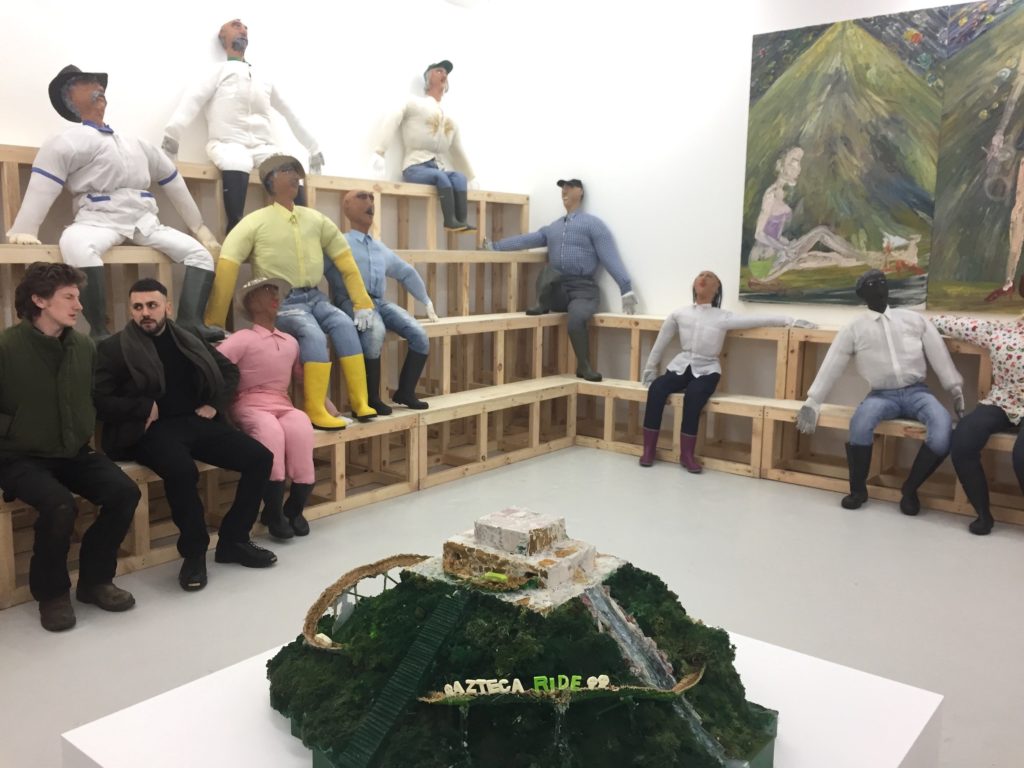
See highlights from the second edition of London's hottest art initiative.

Lorena Muñoz-Alonso

This past weekend, the second edition of the initiative Condo, in which 15 London-based galleries lend their spaces to 21 international galleries to stage collaborative exhibitions, launched in the British capital, giving the city a taste of what the Gallery Weekend that it doesn’t (yet) have could look like.
The weather wasn’t particularly forgiving for the strenuous gallery route, which involved gallivanting across the city in the freezing January cold, complete with intermittent showers, and covering dozens of miles by whatever means of transport one could muster.
But art people tend to be resilient and committed and, judging by the number of familiar faces I ran into over the weekend, most were willing to do whatever it took to complete the “Condo challenge” in its first 48 hours.
Despite the many returning young galleries—including Arcadia Missa, Southard Reid, Gregor Staiger, and Koppe Astner—the second edition of Condo felt bigger, better, and bolder.
The feeling was perhaps triggered by the presence of two very established London galleries: Sadie Coles HQ and Maureen Paley, whose participation sent the clear message that Condo is no longer the sole turf of “hot” young galleries, and that the big players are now also more than willing to associate themselves and collaborate with younger initiatives (as well as participating in smaller, gallery-led fairs like Independent and Paris International).
As for the exhibitions, the second edition felt overall satisfying, if a bit uneven, as the approaches of the participating galleries were diverse: Sadie Coles and Maureen Paley, for example, allocated separate spaces for their guests. It didn’t feel like the most collaborative strategy, but it worked well in both instances nevertheless.
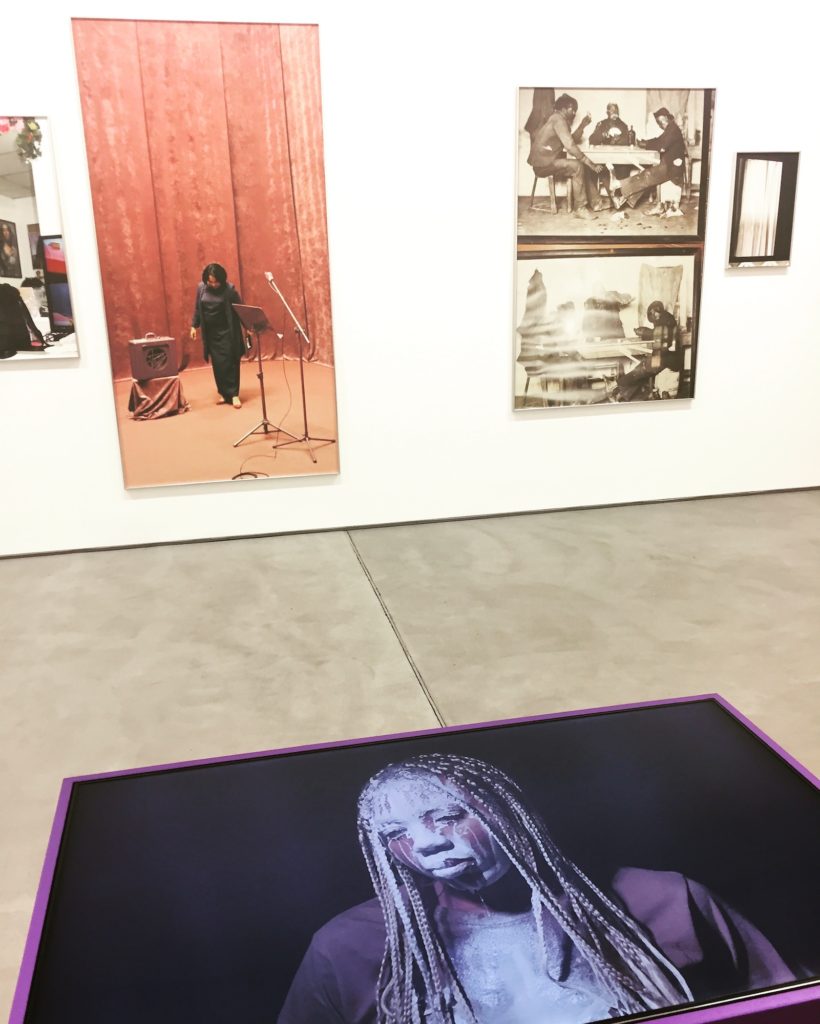
Installation view of Martine Syms’s solo show, represented by Bridget Donahue, and hosted by Sadie Coles HQ, London as part of Condo 2017. Photo Lorena Muñoz-Alonso.
At Sadie Coles HQ, in the heart of London’s Soho, New York’s Bridget Donahue presented a solo show by the young LA artist Martine Syms, who was the subject of a widely praised solo show at London’s ICA last year. Syms explores themes of blackness and the black vernacular in relation to American sitcoms, feminist movements, and radical traditions through video, installation, and performance. Here, the artist presented a series of prints of seemingly everyday snapshots, alongside Lesson LXXV (2017), a hypnotizing video of a black woman who has been covered in a white gooey substance, creating an image both fascinating and disturbing.
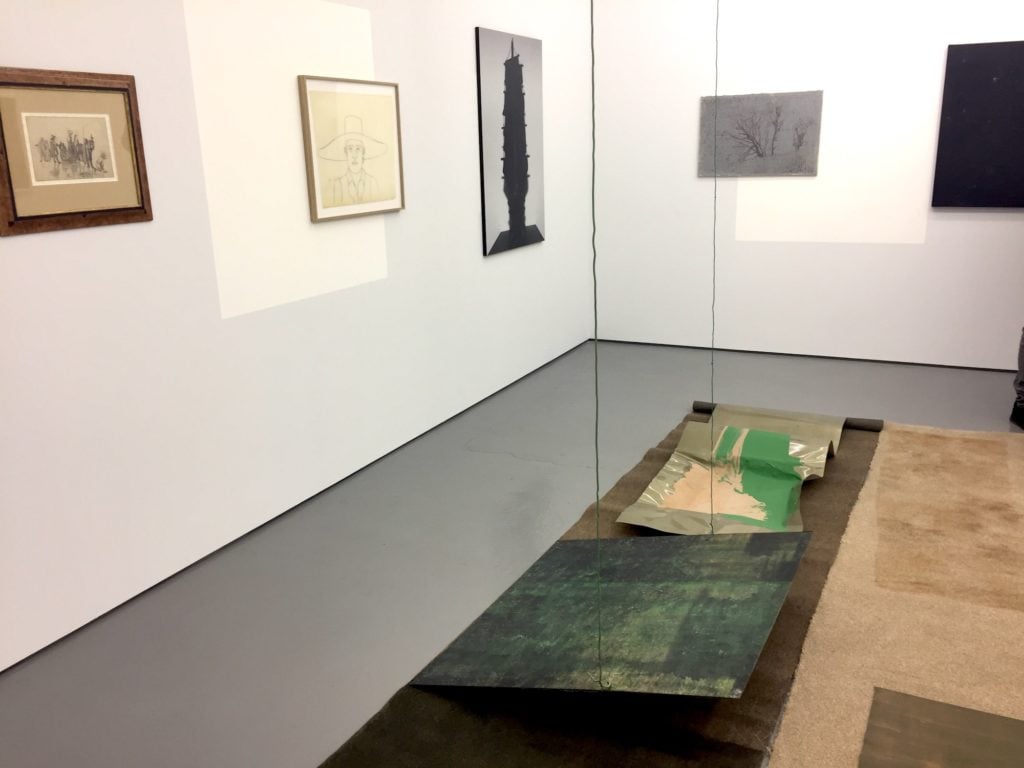
Installation view of the exhibition of Brussels’ gallery dépendance at Maureen Paley, London, as part of Condo 2017. Photo Lorena Muñoz-Alonso.
Meanwhile, in East London, Maureen Paley gave Brussels gallery dépendance quite a small room at the back of its first floor. Yet, the resulting show—showcasing gallery artists like Nora Schultz, Thomas Bayrle, Jos de Gruyter & Harald Thys, Haegue Yang, Maaike Schoorel, and Sergej Jensen—was a perfect sampling. The display, articulated around a phenomenal sculptural floor piece by Schultz, includes a number of framed drawings, photographs, and paintings hung on walls next to geometrical white patches, like the ghostly remnants of past hangings, which gave the whole room an air of a cabinet of curiosities, hung salon style.
Nearby, The Approach is hosting the fantastic New York gallery Simone Subal, which brought work by the Lisbon-born, Boston-based artist Sonia Almeida. The presentation combined a tapestry installation, Weaving Code (2017) with a number of bright works on paper full of art historical references, all building on Almeida’s explorations of codes of communication, both gestural or linguistic.
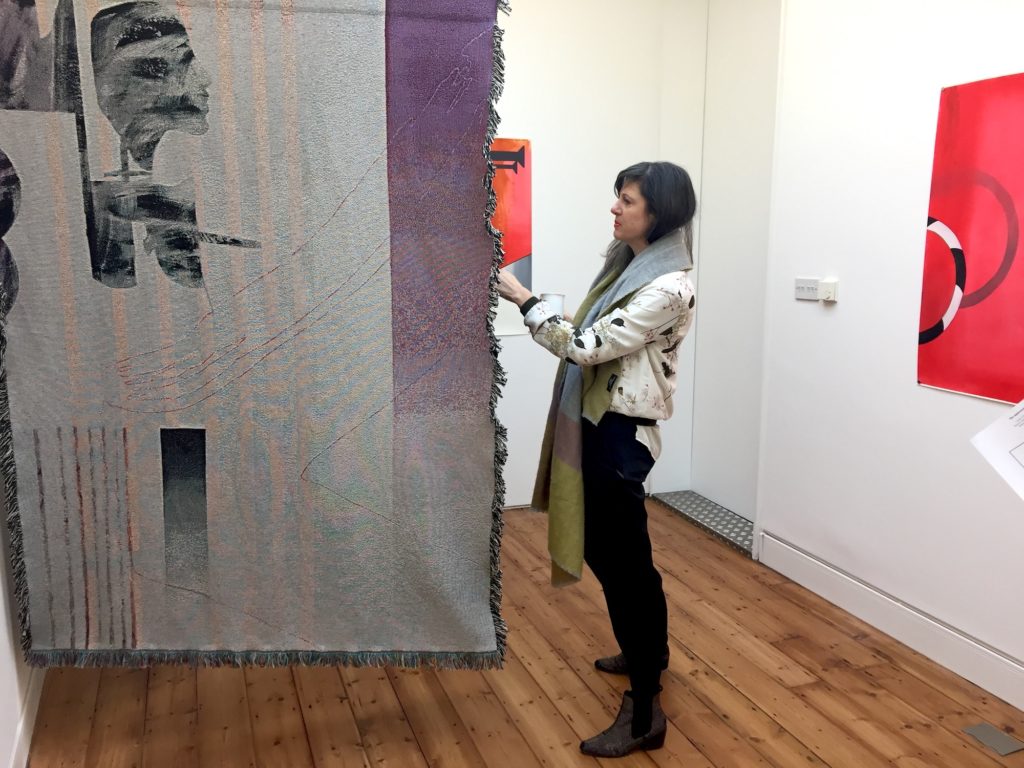
Gallerist Simone Subal explaining the work of Sonia Almeida at The Approach, London, as part of Condo 2017. Photo Lorena Muñoz-Alonso.
Towards Whitechapel, Carlos/Ishikawa put on one of the most impressive exhibitions of this edition (which seems fitting, since it was the gallery’s founder and director, Vanessa Carlos, who devised and launched Condo last year). The show, called “Flying Moths,” features a huge installation and performance by Oscar Murillo; a painting by Ouyang Chun, courtesy of the Shanghai gallery ShanghART, and a sculpture by Yutaka Sone courtesy of the Antwerp gallery Tommy Simoens.
“This is an artist-led collaboration,” Carlos told artnet News on Saturday. “Oscar [Murillo] has been in conversation with Ouyang [Chun] and Yutaka [Sone] for a while, so we approached the galleries to make this collaboration between the artists happen, rather than other way around.”
The resulting show definitely feels like a collaboration rather than a group of works thrown together for commercial purposes. Murillo’s Human Resources (2016) is a huge installation that occupies the whole gallery floor. In it, a wooden tiered structure creates an auditorium space, where dozens of stuffed dolls with papier mâché effigies are sitting down, like vacant spectators. This type of uncanny effigies are burnt in some Colombian towns and cities as part of a New Year’s tradition, in which the bad memories of the ending year are, literally, scorched. In a nod to a previous work (remember the big 2014 Murillo show at David Zwirner in New York, “A Mercantile Novel,” in which he installed a factory of candy brand Colombina?), some of the dolls at Carlos/Ishikawa are wearing Colombina uniforms.
“The show has unity, in that it features artists from the peripheries of art: Colombia, Japan, China… It also has a certain Outsider art feel to it,” Carlos told artnet News, moments before a friend of Murillo entered the auditorium to serenade the present viewers, and perhaps even the dolls, with Colombian ballads from the 1980s.
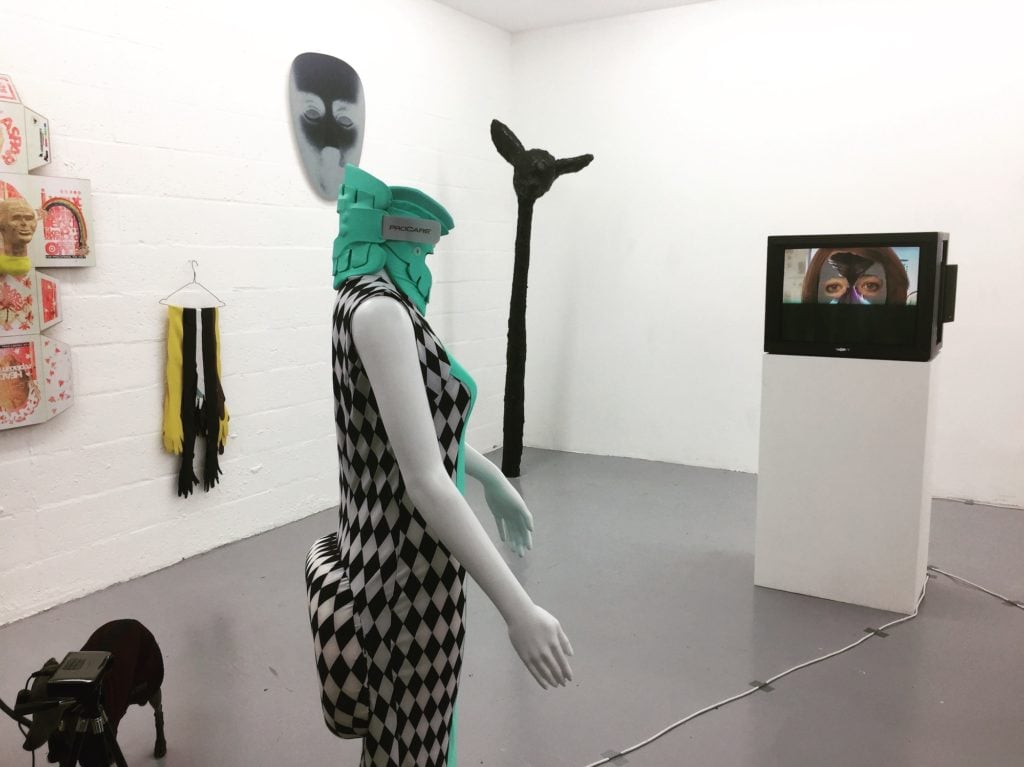
Works by Shana Moulton, courtesy of Gregor Staiger, and Kiki Kogelnik, Amanda Ross-Ho, John Russell, and Nicholas Cheveldave, courtesy Emalin, at Emalin, London. As part of Condo 2017. Photo Lorena Muñoz-Alonso.
In Shoreditch, the gallery Emalin, launched in 2014 by Leopold Thun (son of Memphis designer Matteo Thun), has put on a winner of a show in collaboration with Zurich’s Gregor Staiger. The success of the exhibition was not only due to the artists on display—the always wonderful Shana Moulton, courtesy of Gregor Staiger, and a host of great artist courtesy of Emalin, including Kiki Kogelnik, Amanda Ross-Ho, Evgeny Antufiev, and Michael Sailstorfer—but also because both galleries were working together in the space, rather than operating in separate boxes.
South of the river, Arcadia Missa also presented a superb collaborative exhibition with the Oslo gallery VI, VII. The main piece was a fantastic tent-shaped installation of paintings on silk by London-based artist Emma Talbot, a sort of epic “painting-as-memoir-as-therapy” in which the artist explored the topics of menstruation, birth, and motherhood, also displaying certain tinges of Outsider art. Complementing the presentation were a couple of blown glass sculptures by Than Hussein Clark, a texturized abstract painting by Brad Grievson, and a sculpture by Eloise Hawser.
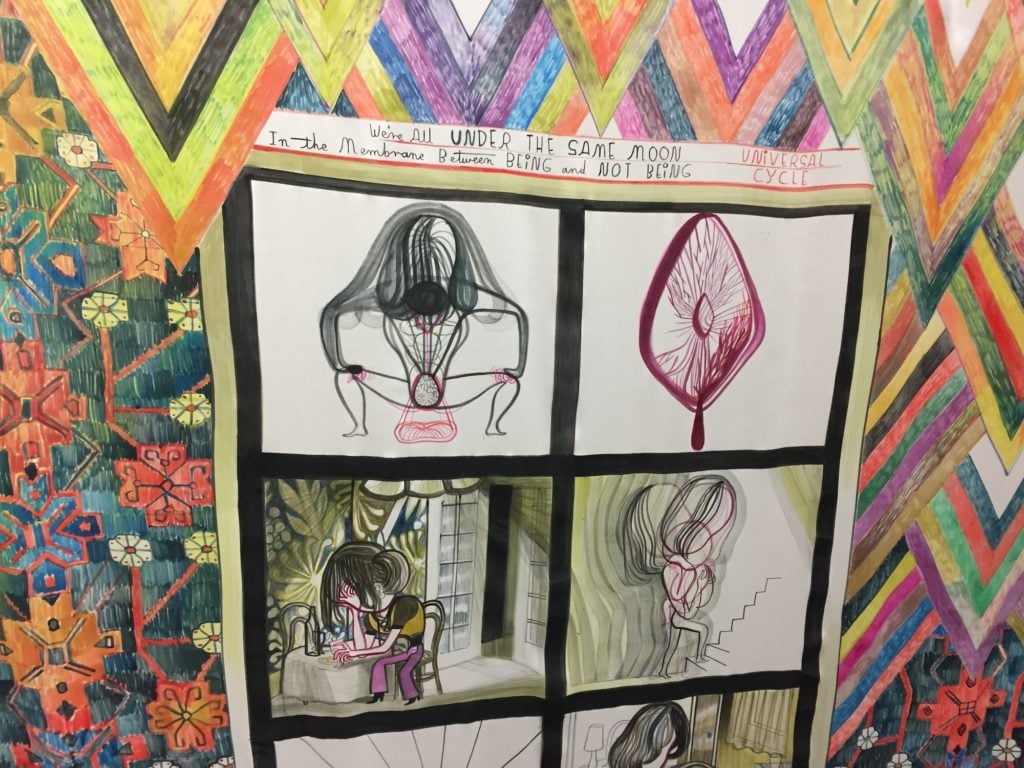
Emma Talbot, detail from You Do Not Belong to You (Universal Story) (2016) at Arcadia Missa, as part of Condo 2017. Photo Lorena Muñoz-Alonso.
Also in Peckham, The Sunday Painter was generously hosting not one but three galleries: São Paulo’s Galeria Jaqueline Martins, London and New York’s Seventeen, and Warsaw’s galeria stereo. At the space, hilarious ceramics by Emma Hart meet paintings by Justin Fitzpatrick, minimal sculptures by Adriano Amaral, and drawings by Wojciech Bąkowski.
Meanwhile, Greengrassi was hosting the rising gallery Proyectos Ultravioleta from Guatemala City, which brought an effective selection of gallery artists including Naufus Ramírez-Figueroa, Felipe Mújica, Johanna Unzueta, and Elisabeth Wild.
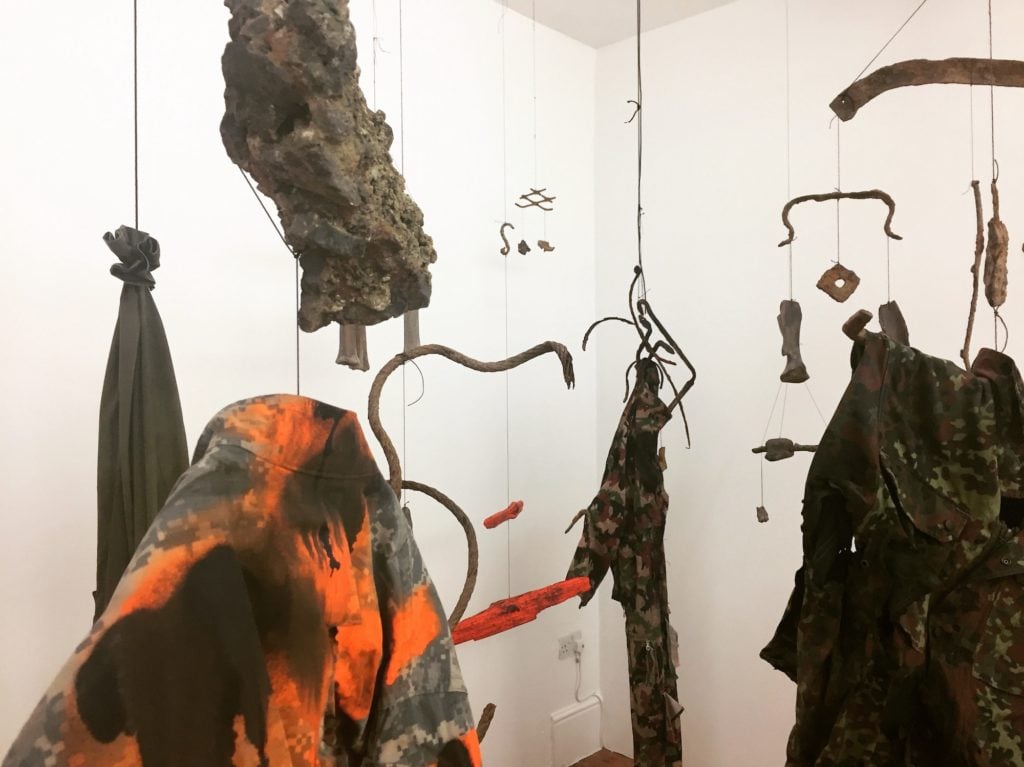
Installation by Franziska Lantz, represented by Supportico Lopez, hosted by Rodeo, London, as part of Condo 2017. Photo Lorena Muñoz-Alonso.
Back in the center of London, Rodeo was hosting Berlin’s Supportico Lopez, which had brought a fantastic dystopian installation by artist and musician Franziska Lantz, consisting of hanging sculptures, or mobiles, made with found stuff that had been washed up on the banks of the river Thames, soundtracked with an electronic music piece by the artist.
Wrapping up the journey, I ended up back in Soho, where Southard Reid had lent Glasgow gallery Koppe Astner its top floor space to stage a solo show by Estonian artist Kris Lemsalu, featuring strange ceramic dogs curled up in sleeping bags, which felt both charming and disturbing (bringing to mind, perhaps unwittingly, the homeless people and refugees who will have no shelter during this freezing winter).
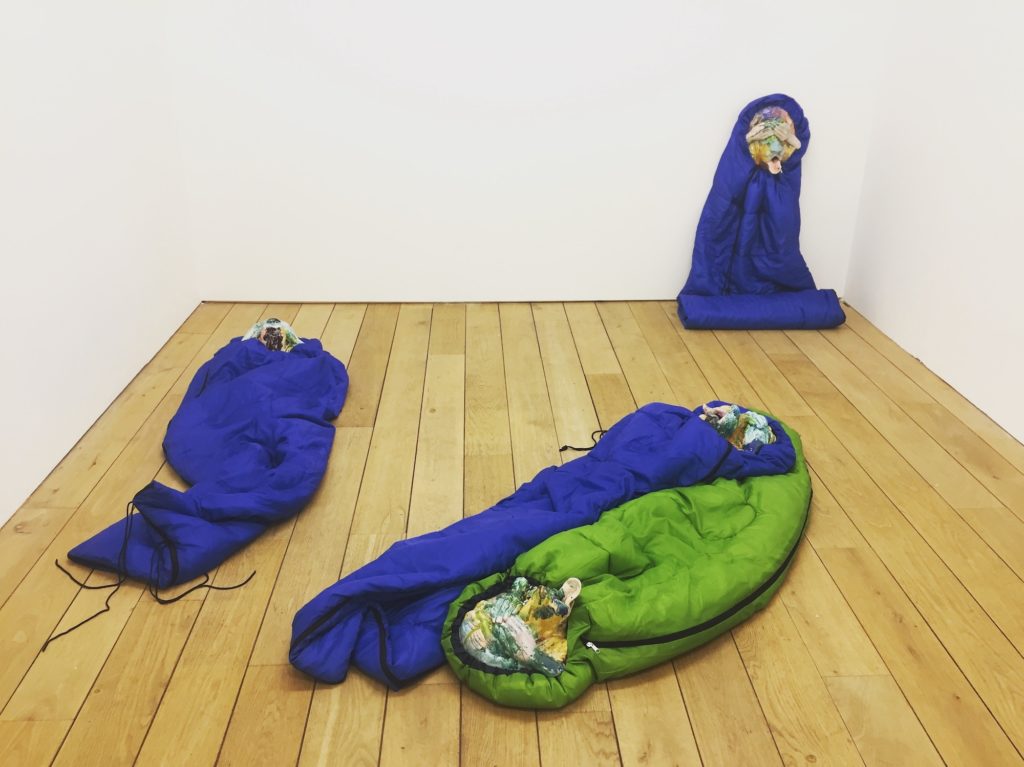
Works by Kris Lemsalu, represented by Koppe Astner, hosted Southard Reid, as part of Condo 2017. Photo Lorena Muñoz-Alonso.
It felt like the perfect note to end the route on, seeing as many Condo shows seemed to tiptoe on political, gender-, and race-related themes in a refreshingly light-handed fashion (which is not the same as “superficial”).
Gallery spaces were shared; people were bumped into and schmoozed; conversations—some shallow, yes, but some less so—were struck; and some galleries off the beaten track, both from London and abroad, were re-visited and discovered by many art lovers and collectors.
And to achieve all that on a freezing weekend, in a much more relaxed context than say, the ever-frantic Frieze Week, seems like a success to me, and a much-needed reminder that an art world in which sharing resources and coming together is possible, regardless of the pressures of the art market—even if only for a little while.
Condo continues until February 11, 2017 in 15 galleries across London.